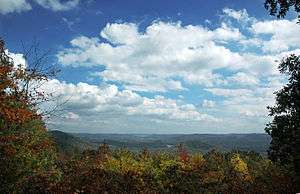Southeastern mixed forests
| Southeastern mixed forests | |
|---|---|
|
| |
 | |
| Ecology | |
| Biome | tropical and subtropical coniferous forest |
| Bird species | 212[1] |
| Mammal species | 66[1] |
| Geography | |
| Area | 347,800 km2 (134,300 sq mi) |
| Country | United States |
| States | |
| Conservation | |
| Habitat loss | 26.905%[1] |
| Protected | 3.73%[1] |
The Southeastern mixed forests are an ecoregion of the tropical and subtropical coniferous forest Biome, in the Eastern United States.
Setting
This ecoregion covers the Piedmont region of the eastern United States, stretching in a broad arc from Maryland southwest to Mississippi. It is distinguished from neighboring ecoregions by elevation and vegetation. At lower elevations to the east are the Middle Atlantic coastal forests on the Atlantic coastal plain. Similarly, the Southeastern conifer forests occupy the Gulf coastal plain to the south. Higher, and to the north and west, are the Appalachian-Blue Ridge forests and the Appalachian mixed mesophytic forests of the Appalachian Mountains.[2]
Climate
This ecoregion has a humid subtropical climate with warm summers and significant precipitation in all seasons.
Flora
Both oaks (Quercus spp.) and hickories (Carya spp.) are abundant in this ecoregion.[3][4][5] Additionally, some 3,635 species of native herbaceous and shrub species have been recorded here.[2]
American chestnut (Castanea dentata) was formerly an important tree in this ecoregion, but its population was destroyed by the chestnut blight in the early 20th century. It still persists as an understory tree, but is often killed by the blight before it matures.[6]
Oak-hickory forests
The most common oaks (Quercus spp.) of this ecoregion are white oak (Quercus alba), northern red oak (Quercus rubra), black oak (Quercus velutina), and scarlet oak (Quercus coccinea). Black and scarlet grow in open forests. Black oak grows in nearly single-species stands on dry, exposed sites. Scarlet oak grows in various habitats. Chestnut oak (Quercus prinus) is found on ridgetops.[6]
The hickories (Carya spp.) of this ecoregion are identifiable by their pinnately compound leaves. They include pignut (Carya glabra) and mockernut hickory (Carya tomentosa), both of which grow on a variety of sites from dry ridges to mesic habitats.[6]
Understory trees include sassafras (Sassafras albidum), hophornbeam (Ostrya virginiana), and green hawthorn (Crataegus viridis). Flowering dogwood (Cornus florida) blooms in early spring.[6]
Shrubs include highbush blueberry (Vaccinium corymbosum), lowbush blueberry (Vaccinium angustifolium), mapleleaf viburnum (Viburnum acerifolium), huckleberry (Gaylussacia baccata), mountain laurel (Kalmia latifolia).[6]
Common pine (Pinus spp.) species are shortleaf pine (Pinus echinata) and loblolly pine (Pinus taeda). The pine forests are regenerated by fire. Without fire, hardwood species grow in below the pines.[2]
Sugar maple (Acer saccharum), a shade tolerant tree, grows amid the oaks and hickories in the northern part of this ecoregion.[6]
Mesic forests
Mesic forests occur in fertile, mesic, low-elevation habitats such as deep ravines and sheltered north- or east-facing slopes. Dominant trees include American beech (Fagus grandifolia), tulip tree (Liriodendron tulipifera), northern red oak, white ash (Fraxinus americana), black maple (Acer nigrum), sugar maple (Acer saccharum), basswood (Tilia americana), and bitternut hickory (Carya cordiformis).[7]
Understory trees include pawpaw (Asimina triloba) and painted buckeye (Aesculus sylvatica).[7]
Mesic mixed hardwood forests
Mesic mixed hardwood forests grow on mesic uplands, ravines, lower slopes, and well-drained flatwoods. Typical trees are American beech, tulip tree, various oaks and hickories, and several other hardwoods. Understory trees include American hornbeam (Carpinus caroliniana), flowering dogwood (Cornus florida), and American strawberry-bush (Euonymus americanus).[8]
Successional forests
Successional forests include eastern juniper (Juniperus virginiana), black locust (Robinia pseudoacacia), and quaking (Populus tremuloides) and bigtooth aspen (Populus grandidentata).[6]
Remaining intact habitat
- Sumter National Forest
- Uwharrie National Forest
- Bienville National Forest
- Talladega National Forest SW unit
- Oconee National Forest
- Piedmont National Wildlife Refuge
- Sauratown Mountains
- Brushy Mountains (North Carolina)
- South Mountains (North Carolina)
- Tunica Hills in southwestern Mississippi and eastern Louisiana
- Arlington Woods, Arlington House, The Robert E. Lee Memorial, Virginia
- Duke Forest
- William B. Umstead State Park
- Eno River State Park
- Guilford College
References
- 1 2 3 4 Hoekstra, J. M.; Molnar, J. L.; Jennings, M.; Revenga, C.; Spalding, M. D.; Boucher, T. M.; Robertson, J. C.; Heibel, T. J.; Ellison, K. (2010). Molnar, J. L., ed. The Atlas of Global Conservation: Changes, Challenges, and Opportunities to Make a Difference. University of California Press. ISBN 978-0-520-26256-0.
- 1 2 3 "Southeastern mixed forests". Terrestrial Ecoregions. World Wildlife Fund.
- ↑ Fleming, G. P.; Patterson, K. D.; Taverna, K.; Coulling, P. P. (2010). "Natural Communities of Virginia - Terrestrial System - Low-Elevation Dry and Dry - Mesic Forests and Woodlands: Basic Oak-Hickory Forests". Virginia Department of Conservation and Recreation, Division of Natural Heritage.
- ↑ Fleming, G. P.; Patterson, K. D.; Taverna, K.; Coulling, P. P. (2010). "Natural Communities of Virginia - Terrestrial System - Low-Elevation Dry and Dry - Mesic Forests and Woodlands: Oak Heath Forests". Virginia Department of Conservation and Recreation, Division of Natural Heritage.
- ↑ Fleming, G. P.; Patterson, K. D.; Taverna, K.; Coulling, P. P. (2010). "Natural Communities of Virginia - Terrestrial System - Low-Elevation Dry and Dry - Mesic Forests and Woodlands: Acidic Oak-Hickory Forests". Virginia Department of Conservation and Recreation, Division of Natural Heritage.
- 1 2 3 4 5 6 7 Kricher, John; Morrison, Gordon (1998). Eastern Forests: A field guide to birds, mammals, trees, flowers, and more. Houghton Mifflin Harcourt. ISBN 978-0-395-92895-0.
- 1 2 Fleming, G. P.; Patterson, K. D.; Taverna, K.; Coulling, P. P. (2010). "Natural Communities of Virginia - Terrestrial System - Low Elevation Mesic Forests: Basic Mesic Forests". Virginia Department of Conservation and Recreation, Division of Natural Heritage.
- ↑ Fleming, G. P.; Patterson, K. D.; Taverna, K.; Coulling, P. P. (2010). "Natural Communities of Virginia - Terrestrial System - Low Elevation Mesic Forests: Mesic Mixed Hardwood Forests". Virginia Department of Conservation and Recreation, Division of Natural Heritage.
